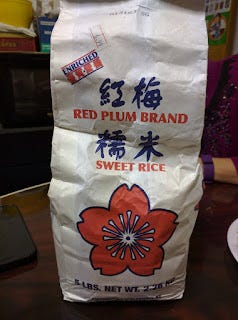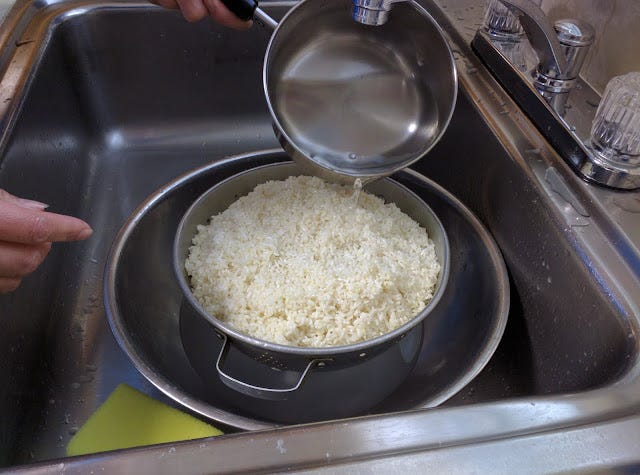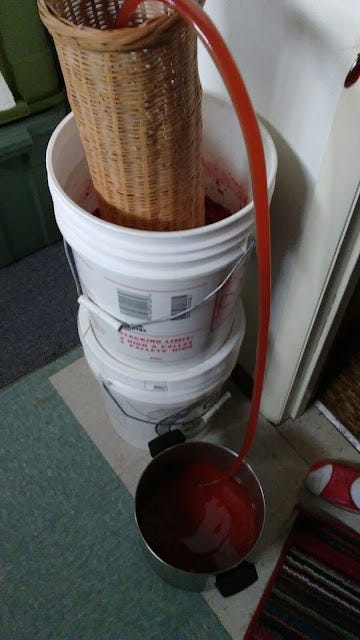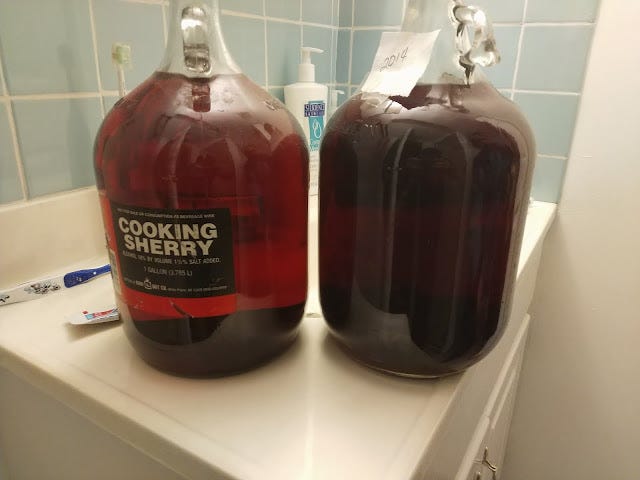Growing up, it was common to see most of my aunts making their own wine. This practice traces back thousands of years in China, and is used to produce 3 types of outputs: (1) The high quality wine is stored in bottles and aged over years. This wine is commonly offered during banquets and ceremonies in small cups. The legend goes that families will start a bottle the year a child is born, only to be opened on their wedding day. (2) The lower quality wine is stored separately as a cooking wine, used in soups and stir-fries for flavoring. (3) The remaining red wine lees are jarred, used in a variety of recipes, such as Conch with Red Wine Lees, 红酒糟炒螺片 or Red Wine Lamb Soup, 红糟煮羊肉汤.
This fermentation process is quite simple and consists of only a few ingredients. However, it is incredibly sensitive to impurities, so take extra caution to clean all utensils, bowls, and hands. Otherwise after months of work, you may just end up with a really strong vinegar.
Ingredients
10 lb long-grain sweet rice (short-grain is acceptable too)
14 oz red yeast rice
20 cups of distilled water
Cooking Tools
1x Thai-style rice steamer
1x large food-safe bucket with airtight cover
Multiple large glass bottles or ceramic urn with airtight cover
1x Thai-style bamboo strainer
rubber hose - for siphoning wine
saran wrap and parchment paper
rubber bands
Cleaning glassware and utensils:
It is absolutely critical to have crystal clean tools and glassware for this recipe. Use 白灰 or baking soda with warm water, soaking for a few days to clean any utensils and bowls that you plan to use.
Steps
Measure 10lb of sticky rice and place it into a food-safe bucket.
First we're going to clean the rice. Add enough water to soak all of the rice, no need to be precise.
Lightly cover the bucket to prevent bugs from getting in. Let the rice soak overnight, releasing excess starch into the water.
Whenever dealing with the rice, make sure your hands are VERY VERY clean. Any residual oils will affect the taste of the wine.
Carefully clean the rice in cold water until the water is clear.
One way to tell when you're done cleaning is to pour cold water through the rice. If the water is clear on the other side, you're ready to begin cooking.
At this stage, drain the rice and give ample time to let the rice dry.
Place 14 oz of red yeast rice in the food safe bucket.
Add precisely 20 cups of distilled water as described in the ingredients list. This water will eventually become the wine. You should be using clean distilled water, but don't be afraid to experiment with different water sources. The quality of the water has a huge effect on the wine.
Use a clean wooden dowel to lightly mix it evenly.
NOTE: Take extra care not to accidentally introduce any oils or other substances into this mixture. Any tools should be washed in boiling water before use. We're going to repeat this warning multiple times.
In theory, the rice can be cooked in any rice cooker. We prefer to use traditional Thai-style rice steamers, which can be bought online. Add water to the basin and bring the water to a boil on the stove.
Only after the water is at a boil, put a small batch of rice on the cooker in the woven basket.
NOTE: The bottom of the basket should NOT touch the water. If there's too much water, pour some out.
Steam on high until the rice has cooked.
Slowly add more rice by hand to the basket as it cooks in layers.
Once the last layer of rice has finished cooking, pour boiling water over the rice and cook for another few minutes.
Batch 1! Repeat until you've cooked all the rice. Place the rice aside to cool after cooking.
Let the rice cool for several hours to room temperature.
Once all the rice is cooked and cooled to room temperature, carefully add the rice to the red rice/water mixture.
NOTE: Take extra care not to introduce any oils or other substances into this mixture. Any tools should be washed in boiling water before use. Hands should be washed very well. Seriously.
Mix everything together by slowly and methodically stirring in a single direction.
DO NOT change the direction of stir. It messes with the juju.
This is what the mixture should look like by the end of stirring.
Now cover the bucket with a lid, and leave the bucket for 2 weeks at room temperature. Basements work well for this.
Note: This does not need to be an airtight lid.
After 2 weeks, sterilize a mixing spoon by cleaning in boiling water. Remember, a dirty spoon will completely ruin the wine! Open up the bucket. You should smell alcohol and wine, with the wine settled on the bottom of the bucket, below the rice. Carefully stir the rice-water mixture in a single direction for a few minutes. Again, juju.
Mix for 2 minutes.
Now we must create an airtight lid for the bucket. We suggest using saran wrap to first cover the top, using either tape or string to firmly seal to the bucket. Then put the lid on last. When done, store the container in a dark and cool location. Again, basements work well.
After 2 months, we want to separate the rice from the liquid before we continue aging the wine. We suggest using a Thai-style bamboo strainer. Remember to clean it with boiling water before use.
By placing the strainer into the bucket, you create a pocket of liquid that is separated from the rice.
Then using a rubber hose to suction the wine off into a separate container, kind of like when you go to steal gas from your neighbor's car. Notice the difference in elevation so you can let gravity do the work.
Now pour the wine into a separate glass bottle. You can use a funnel, but be sure to clean it well with boiling water first.
It is critical to seal the glass bottle really well, as we'll age the wine for years in this bottle. We recommend first using a layer of parchment paper, then saran wrap, then the bottle cap. Finally clamp it all down with rubber bands. If air sneaks into the bottle, it'll alter the taste. Hide this bottle in a dark cool corner part of the basement away from sunlight.
In the bucket, you are left with a thick rice mixture (lees), which we recommend saving into a separate jar. Again, we recommend an air-tight lid. The red wine lees can be stored for months in the refrigerator and is used for cooking.
Asian-American culture dictates that we should reuse bottles from 10 years ago.
The red wine lees might be even more valuable than the wine, as we'll use it a number of other recipes such as lamb soup, noodle soup, and stir-fried conch. Here's a photo of aged-pork marinated in these red wine lees. Yum!
As for the wine? The rice wine should be kept in airtight bottles in a cool, dark, and dry place, away from sunlight. My aunt stores it in between the walls of the basement, in a location more secure than her jewelry. The wine should be aged for as long as possible, growing darker in color over time. The wine will become smoother and more flavorful over time as well. In the picture below, the left jar has been aging for 2 years and the right jar has been aging for 4 years. Notice the color difference (ignore the labels from the 80's). We once tried a sip from 2, 3, 4, and 5 year old wine batches. The 5-year-old wine was definitively better.






































